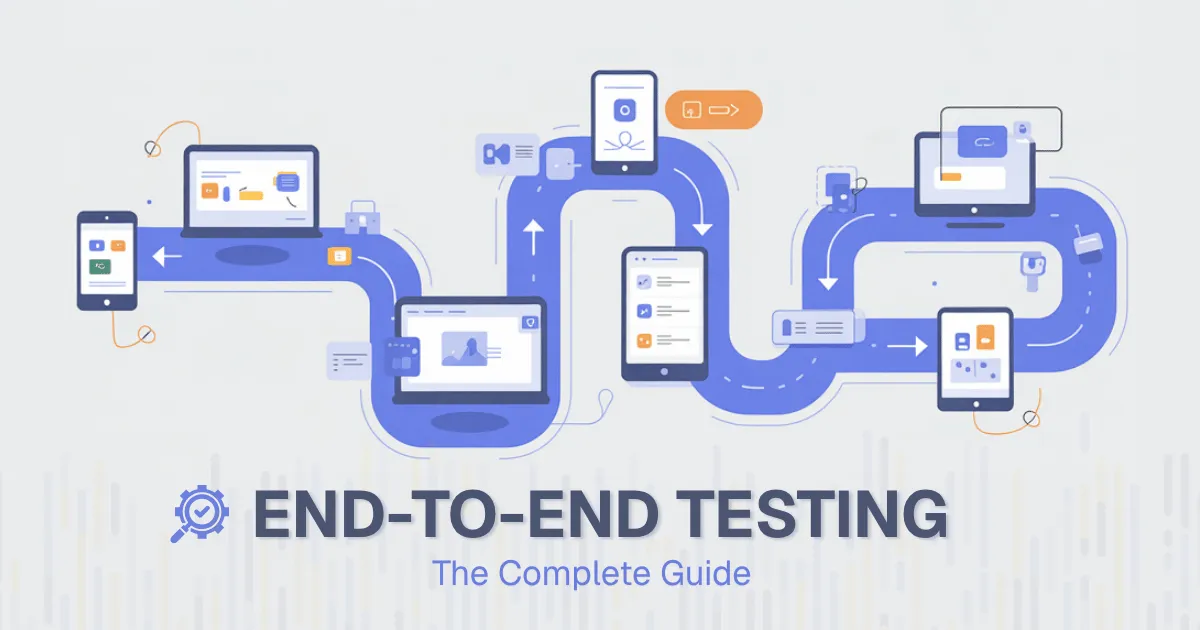The Complete Guide to End-to-End Testing


I remember perfectly the day when everything went wrong right after the release. It was ten in the morning, we had just sent out a big marketing email, and the signup page of our site suddenly froze. I remember diving straight into the logs to look for errors and found nothing. All the tests were green, while real users were seeing nothing but an endless loading spinner on their screens. At that moment I realized: as long as I don’t test the product the way a person uses it, I’m not really testing, I’m just hoping for luck.
This material is my experience, the very thing I badly needed back then. No complicated theory or obscure terms. Only specific steps that truly help, a bit of real code, and the mistakes I made then and never want to repeat.
What an End-to-End (E2E) Test Really Is?
An E2E test pretends to be a human:
- Open your app in a browser or device simulator.
- Click “type”, and scroll like a real person.
- Check that the screen shows the correct thing.
That’s it. Simple idea, huge impact.
Tiny Example: Add a Task
Imagine a simple to-do web app. A user should be able to add a task and see it in the list.
// e2e/add-task.test.js
import { test, expect } from '@playwright/test';
test('User adds a task', async ({ page }) => {
await page.goto('<https://todo.example>');
await page.fill('[data-test=new-item]', 'Buy milk');
await page.press('[data-test=new-item]', 'Enter');
await expect(page.locator('[data-test=item-text]:last-child'))
.toHaveText('Buy milk');
});
This matters because if any part of the stack like API, database, front-end—breaks, that last expectation fails. One red X beats a thousand green unit tests.
Pick the Right Flows First
You can’t test every pixel on day one. Start with flows that cost money or reputation when they break.
In my teams we always ask one question: “If this fails in production, who loses sleep?” Anything that keeps someone up at night goes on the list:
- Logging in
- Paying for something
- Resetting a password
- Saving core user data (tasks, photos, orders)
Write those down, nothing else. You’ll expand later.
Stable Data = Stable Tests
Good tests need predictable ground to stand on. Here’s what works for me.
1. Own a Test Database
Spin up a dedicated database seeded with known records before each run.
# scripts/seed.sh
psql "$TEST_DB" < schema.sql
psql "$TEST_DB" < initial_data.sql
Now item task_123 always exists, always says “Buy milk,” no surprises.
2. Stub Outside Calls
If your app fetches weather, stock prices, or maps, swap those endpoints for a stub that returns fixed data. Tests run faster and never break because the real service is down.
Tip: Point the stub URL with an environment variable so production stays untouched.
Live check before you ship
Keep stubs for every push, but run a nightly smoke job on the staging env that flips
USE_STUBS=false
and calls the real APIs with sandbox keys.
One green run there is your final safety net.
# .github/workflows/staging-smoke.yml
jobs:
smoke:
runs-on: ubuntu-latest
env:
USE_STUBS: "false"
steps:
- uses: actions/checkout
- run: npm ci
- run: npx playwright test --config=e2e.smoke.ts3. Use Semantic Selectors
Attribute selectors like data-test="checkout-button" survive redesigns. CSS classes change often; data-test rarely does. Add them in the codebase once and future-you will thank present-you.
Writing Tests That Read Like Stories
Code tells computers what to do; clear naming tells humans why it matters.
await page.fill('[data-test=origin]', 'Paris'); // Where the flight starts
await page.fill('[data-test=destination]', 'Lisbon'); // Where the flight ends
await page.click('[data-test=search]'); // Get available flightsAfter six months, you’ll still understand what each line means. Future teammates, too.
Make Them Fast
Engineers fear E2E because they think it slows CI. Here’s how I keep runs short:
- Parallel jobs—most runners let you split tests across cores.
- Headless mode—browsers without a GUI are lighter.
- Short flows—test one thing per file. If “add to cart” fails, why re-run search and checkout?
- Smart waits—never use
sleep(3000). Wait for a specific element or event.
Quick Win: Parallel Workers
npx playwright test --workers=4Even a medium suite drops from ten minutes to three on a laptop.
Fit E2E into Your Pipeline
Automation that isn’t in CI/CD is a hobby. Add one extra step and treat a red test as a red build.
# .github/workflows/ci.yml
jobs:
e2e:
runs-on: ubuntu-latest
steps:
- uses: actions/checkout
- run: npm ci
- run: npm run start:test &
- run: npx playwright testNote: run the app in test mode, not production. Environment variables keep things separate.
When AI Does the Heavy Lifting
Manual scripts can rot. Modern testing tools watch real user sessions and suggest flows to protect. I’ve used one on an e-commerce site: it noticed most people finished checkout with an express wallet and proposed that path as a test. We clicked “approve,” it generated the code—saved us hours.
What I like:
- It updates selectors when the UI shifts.
- It ranks flows by traffic and revenue so I don’t guess.
- It surfaces flakiness scores, letting me focus on the noisiest parts.
AI doesn’t replace thinking, but it cuts the grunt work.
Metrics That Matter
1. Critical Path Coverage
How many top flows are under test? Aim for 100% of the list you made earlier.
2. Feedback Time
Minutes from commit to test result. Lower is better. Under ten keeps momentum high.
3. Incidents After Release
Track bugs that reach users. Fewer incidents = E2E pays off.
4. False Positives
If tests cry wolf too often, devs ignore them. Keep the noise low.
Collect numbers in your usual dashboard. A line that slopes up or down means more than a gut feeling in a sprint retro.
Common Pitfalls (And How I Dodge Them)
- Testing trivia. A colour change on a marketing banner doesn’t need E2E. Stick to money flows.
- Monsters of Doom. A 300-step script fails somewhere in the middle and you have no idea why. Break it into chunks.
- One shared user. Two parallel tests racing to edit the same record will collide. Use unique data per worker.
- Magic numbers. A hard
wait(5000)hides slow code instead of fixing it. Wait for elements, not time. - Selector whack-a-mole. Adopt
data-testattributes early and changes in layout won’t break the suite.
My Checklist for Debugging
- Re-run the failing test alone.
- Watch the recorded video or screenshot.
- Check console logs for errors.
- Reproduce the steps manually.
- If it only fails in CI, compare environment variables and database state.
Nine times out of ten this flow finds the cause within five minutes.
Wrapping Up
End-to-end tests aren’t exotic; they’re just the product taking a self-guided tour each night. Start small:
- List the flows that wake you up at 2 a.m.
- Add stable seed data.
- Write one short script.
- Hook it into CI.
Do that, and the next release will feel less like roulette and more like science. Want to push even faster? Let an AI tool suggest new flows and update selectors for you. You’ll spend evenings building features instead of hunting flaky tests—and maybe even sleep through that marketing email blast. Get started with QA.tech for free!

Stay in touch for developer articles, AI news, release notes, and behind-the-scenes stories.

